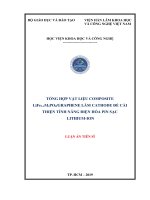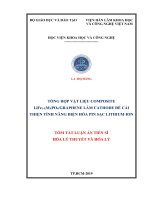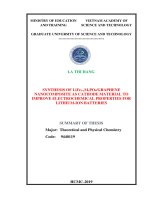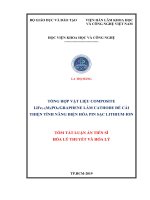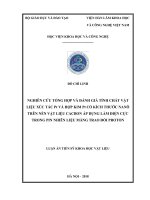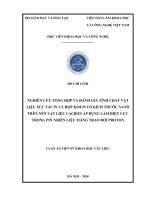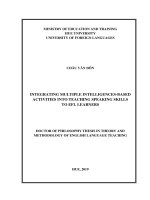luận án tiến sĩ: Tổng hợp vật liệu composite LiFe1xMxPO4Graphene làm cathode để cải thiện tính năng điện hóa pin sạc Lithiumion
Bạn đang xem bản rút gọn của tài liệu. Xem và tải ngay bản đầy đủ của tài liệu tại đây (2.25 MB, 28 trang )
MINISTRY OF EDUCATION
AND TRAINING
VIETNAM ACADEMY OF
SCIENCE AND TECHNOLOGY
GRADUATE UNIVERSITY OF SCIENCE AND TECHNOLOGY
----------------------------------
LA THI HANG
SYNTHESIS OF LiFe1-xMxPO4/GRAPHENE
NANOCOMPOSITE AS CATHODE MATERIAL TO
IMPROVE ELECTROCHEMICAL PROPERTIES FOR
LITHIUM-ION BATTERIES
SUMMARY OF THESIS
Major: Theoretical and Physical Chemistry
Code:
9440119
HCMC-2019
The Thesis has been performed at: Institute of Applied Materials
Science (IAMS) – Graduate University Science and Technology –
Vietnam Academy of Science and Technology (VAST)
……..….…………
Advisor 1: Assoc. Prof. Nguyen Nhi Tru
Advisor 2: Assoc. Prof. Le My Loan Phung
Reviewer 1: …
Reviewer 2: …
Reviewer 3: ….
The thesis was presented at National level Council of Doctoral Thesis
Assessment held at Graduate University of Science and Technology –
Vietnam Academy of Science and Technology at….on……
The Thesis can be stored at:
- The Library of Graduate University of Science and Technology
- -National Library of Vietnam
INTRODUCTION
1. The important role of thesis
These days the seriousness surrounding and pertaining to the-renewable energy crisis can cause
exploited demands to the surrounding ecosystems leading to depletion, pollution and climate change including
the alarming negative effects such as eroded environments. For these reasons, renewable energy should be
increasingly promoted and developed further development and research such as: solar, wind and tide… thereby
reducing our reliance on fossil fuels and the depletion of crucial ecosystems.
However, these resources have huge disadvantages that are intermittent and dependent on conditional
factors related to the climate, so using them poses many challenges for its application. Therefore, solving these
problems requires the creation of efficient energy storage devices for the development of renewable energy
transferred from chemical energy to electrical energy. This is an important role and strategy toward the
improvement of renewable energy for global solutions.
Since the advent of these technologies the rechargeable of Li-ion batteries were born, it brings many
achievements for application science to contribute enhancement of new technology and various type of
batteries for modern electrical and electronic technology. Rechargeable batteries are devices which enable
energy storage and release directly as electricity; by means of highly reversible electrochemical reactions.
Today, this storage dominates market in Portable mobile electronics with more potentials than other devices
consideration:
Large battery power, high energy density, light weight, safe and stability, as well as design flexibility.
With good characteristic, Li-ion batteries could replace traditional storage.
In recent years, Li-ion batteries have been considered the main structure to investigate electrochemical
properties, especially, material electrode. Actually, Commercial rechargeable LiCoO2 for Li-ion batteries with
specific capacity: 248 mAh.g-1 has been the choice material in the predominate market with the electronic
devices in this field since the commercialization by Sony Energitech in 1992. However, this compound using
cathode material has met some limitations with respect to charge-discharge issue, additionally safe, unfriendly
environments at expensive costs (rate of 0.001% Co, 1.5% Fe in the Earth).
LiFePO4 structural olivine is excellent choice with prolonged it’s life time, deeply cycle stability,
environmental friendliness, and advantageous low cost but olivine structure has only one channel of direction
[010], the intrinsic electronic conductivity of LFP olivine structure. Actually, LiFePO4 (LFP) has one huge
drawback shown due to its rigid orthorhombic and Li+ diffusion rate is considerably low to reach it’s full
theoretical capacity during battery operation. Plainly, it’s oxidation properties from Fe2+ to Fe3+ make it a less
suitable choice, these problems lead to poor performance with Li-ion batteries to meet some challenges due
with commercialization. To solve this problem, researchers in the world focus on improvement of ionic
conductivity (10-9-10-10 S.cm-1) and diffusion coefficient (10-12-10-14 cm2.S-1) ion Li+ in order to enhance higher
capacity in a high rate charge-discharge by this method of expansion; instinct-LFP: doping metal as a new
material LiFexM1-xPO4 (LFMP) or coating carbon (LFP/C) and reduced size.
Recently, the publication of these materials using cathode to enhancement of electrochemical
properties for Li ion batteries have related to doping metals or coating graphene as individuality instead of
linking together in recent decades. Furthermore, the number of international publications on metal-doped
LiFePO4 materials and coated and graphene has been limited with LiFexM1-xPO4/graphene composite nano
materials less or none of researches studied deeply the differences with several kinds of electrochemical
performance by evaluation of the kinetic element of Li+ ion diffusion process into olivine structure. According
1
to international publications in the world as well as inheriting previous research based knowledge, this thesis
was chosen as its basis. “Synthesis of LiFexM1-xPO4/graphene nanocomposite as cathode material to improve
electrochemical properties for lithium-ion batteries. In this study, therein, survey the influence various rate
of metal-doped materials on diffusion kinetic process of ion Li+ to distinguish electrochemical properties
before and after doping metals.
Besides, graphene coated-LiFe1-xMxPO4 materials as nanocomposite LiFe1-xMxPO4/graphene was
investigated scope of olivine structure, morphology and the role of their improvement of electrochemial
properties. The research results offered considerable contributions of solving the urgent problems for LFP
materials to offer new rechargeable batteries with at inexpensive price including safety and environmental
friendliness. LFP cathode is also a promising material for use in rechargeable batteries in electric vehicles
compared to the lithium oxide layer structure materials using Co, Ni due to low toxicity and abundant in nature.
2. The target of thesis
Nanocomposite material LiFe1-xMxPO4/Gr was successfully synthesized achieving it with single phase.
It’s response required electrochemical parameters of positive electrode materials for Li-ion batteries such as:
improved diffusion coefficient and conductivity, higher capacity comparative with LFP in same conditional
synthesis. There are the specific ideas.
- Investigations relation of the process’s of synthesis in structural olivine LFP by the solvothermal
method and investigation of different synthesized parameters such as: temperature, solvent and the ratio of
precursors.…
- Investigations in the process of structural olivine was synthesized by solvothermal method, analysis
and appreciation of structure, morphology and the chemical components of compound.
- The Study of kinetic process of lithium extraction/insertion after doped metal-LFP with various
ratio of weight Mn+ (Ni, Mn, Y). We also evaluate the linkage between graphene thin film materials, LiFe1xMxPO4/Gr
structure as well as graphene's role in electrical conductivity and electrochemical properties of
materials.
- Investigations in the performance of LiFe1-xMxPO4/Gr materials for cathode Li-ion batteries
(capacity, cyclic) in in the model CR2032.
NEW CONTRIBUTIONS OF THE THESIS
1. LiFe1-xMxPO4/C nanocomposite was synthesized via solvothermal method by simultaneously doping
various metals such as: Mn, Ni, Y, etc and carbon coating. The carbon coating is itself from two
separate sources: organic carbon (in situ) and graphene (ex situ) powder. with LiFe1-xMxPO4/C material
crystals of graphene honeycomb network based on the difference in electronegativity of the atoms
creating the effect of charge attraction between graphene and LFMP hexagonal networks to create
composite materials with structure sustainable structure and excellent electrochemical performance.
In contrast, previously published research only involves either graphene coating on LiFePO 4
(LiFePO4/Gr) or doping M metals into the structure of material for LiFe1-xMxPO4 synthesis.
2. It was empirically shown that after doping with M metals, the structure of the resultant materials is
linearly retained without alterations to the olivine structure, in accordance with Vegard’s Law.
3. With doping metal and coating graphene, the synthesized LiFe1-xMxPO4/C material exhibits behaviors
with Li+ ions’ movements through the olivine structure is predominantly controlled by the diffusion
Warburg mechanism. This is the theoretical basis for improving electrochemical efficiency through
2
enhancing the diffusion coefficient and conductivity (5,1.10-3 S.cm-1) increasing 104-105 times (in
comparison with LiFePO4 theory), resulting in specific capacity reaching 155-165 mAh.g-1 at C/10
remaining 96% after 20 cycles.
4. Using solvothermal method, LiFe0.8Mn0.2PO4/5%Gr has been successfully fabricated achieving
specific capacity approximately equivalent to theoretical value of LiFePO4. The weight ratio of 20%
Mn and 5% graphene can therefore be used to prepare LiFe1-xMxPO4/C as cathode materials for
rechargeable Li-ion batteries, opening up new opportunities for expanding the scope of applications at
a higher capacity.
PUBLICATIONS
1. Huynh Le Thanh Nguyen, Nguyen Thi My Anh, Tran Van Man, La Thi Hang, Tran Thu Trang, Tran
Thi Thuy Dung, Electrode composite LiFePO4@carbon: structure and electrochemical performances,
Journal of Nanomaterials, 2019, 1-10 (SCI-E).
2. La Thi Hang, Nguyen Thi My Anh, Nguyen Nhi Tru, Huynh Le Thanh Nguyen, Le My Loan Phung,Modification of nano-sized LiFePO4 via nickel doping and graphene coating, International Journal of
Nanotechnology, 2019, 914-924(SCI-E).
3. Dinh Duc Thanh, Nguyen Thi My Anh, Nguyen Nhi Tru, La Thi Hang, Le My Loan Phung, The
impact of carbon additives on lithium ion diffusion kinetic of LiFePO4/C composites, The Science and
Technology Development Journal, 22(1), 2019, 173 – 179.
4. La Thi Hang, Nguyen Nhi Tru, Le My Loan Phung, Olivine structured LiFexYyPO4/C composite
synthesized via solvothermal route as cathode material for lithium batteries, Vietnam Journal of
Chemistry, 56(6E2), 2018, 267-271.
5. Bui Thi Thao Nguyen, Doan Thi Kim Bong, La Thi Hang, Nguyen Nhi Tru, Hoang Xuan Tung,
Nguyen Thi My Anh, -Modification of Ketjenblack EC-600JD carbon as filler in cathode material for
lithium-ion battery, Vietnam Journal of Chemistry, 56(6E2), 2018, 262-266.
6. Nguyen Thi My Anh, Doan Luong Vu, Nguyen Thai Hoa, Le My Loan Phung, Nguyen Ba Tai, La
Thi Hang, Nguyen Ngoc Trung, Nguyen Nhi Tru- Characterization of LiFePO4 nanostructures
synthesized by solvothermal method. Journal of Science and Technology, Technical universities 118,
2017, 45-50.
7.
La Thi Hang, Le My Loan Phung, Nguyen Thi My Anh, Hoang Xuan Tung, Doan Phuc Luan,
NguyenNhi Tru- Enhancement of li–ion battery capacity using nickel doped LiFePO4 as cathode
material. Journal of Science and Technology 55_1B, 2017, 267-283.
8. La Thi Hang, Nguyen Nhi Tru, Nguyen Thi My Anh, Le My Loan Phung, Doan Luong Vu, Doan
Phuc Luan, –Microwave-assisted solvothermal synthesis of LiFePO4/C nanostructures for lithium ion
batteries, Proceedings of the 5th Asian Materials Data Symposium. HaNoi 10, 2016, 343-352.
CHAPTER 1. INTRODUCTION
This chapter expresses a brief overview of the Li-ion rechargeable battery and the history of it’s
development and research in countries around the world. This secondary rechargeable battery is of special
interest with some advantages in electrochemical properties as well as durability and especially positive trends
impacts on the environment as compared to other chemical traditional storage devices.
3
Studies surrounding the principles of operation the properties of fabrication of the battery. Herein,
analyzing the advantages and disadvantages of the battery to overcome the limitations of energy storage device.
Surveys show that recent studies focus on changing cathode material composition to increase it charging
efficiency and durable battery.
Statistics and collection of documents from various publications about various types of cathode electrode
materials and improvement directions. Specifically, highly studied cathode materials in which the olivine
LiFePO4 (LFP) is considered as the most famous candidate for the family of olivine-type lithium transition metal
phosphates by a relative specific capacity for the cathodes lithium-ion batteries. High capacity (170 mAh.g-1),
flat voltage (3.45 V vs Li+/Li), slight weight, inexpensive (18-20 USD/kg of powder material) due to the amount
of Fe in Earth's crust and nontoxic lead to environmental friendness.
However, commercializing this material is a major barrier because the element Fe is easily oxidized, the
+
Li ion is less flexible because it moves a single diffraction direction [010] in the olivine tunnel structure, resulting
in poor electrical conductivity (10-14 S.cm-1) and low diffusion coefficients (10-12-10-14 cm2.s-1).
The author has surveyed and collected documents from published works, to improve the disadvantages
of LFP materials with various approaches as a key in the electrochemistry. The following consideratiions and
mentions are applicable.
Control particle size (i) nanometer (nm) with nano size (100-350 nm) and well-shape crystals are
important for enhancing the electrochemical properties because of shortening the amplitude of redox potential.
Besides, reducing particle size increases electron density, shortening the distance of Li+ ion diffusion can increase
diffusion coefficients.
Another improvement that is of interest is metal doping (ii) electronic density enrichment that displaces
the potential and increases the electrical conductivity of the material. Doping is good way for stabilizing the
lattice structure of this class of inorganic electroactive materials.
Lastly, It is well-known that carbon as a reducing agent prevents the formation of Fe3+ impurity and
the agglomeration of particles during the preparation of LFP, but it also can significantly improve the battery
performance. Coated-carbon (iii) on the material is also appreciated because it conducts electricity well on large
surface contact areas as a conductive bridge and preventage corrosion of the electrode and limits exposure to the
atmosphere.
CHAPTER 2. EXPERIMENT
2.1.
The route of synthesis LiFePO4, LiFe1-xMxPO4, LiFe1-xMxPO4/Gr
The chemical precursors using synthesis of LFP, LiFe1-xMxPO4, LiFe1-xMxPO4/Gr as: LiOH.H2O (98%,
Fisher); FeSO4.7H2O (99,9%, Fisher); Mn(NO3)2.4H2O (99,98%, Merck); Y(NO3)2.6H2O (99,9%, Merck),
H3PO4 (99,98%, Merck), ascorbic acid (99,87%, Merck); H3PO4 (99,98%, Fisher) ethylene glycol (99, 87%,
Merck), graphene (Merck).
The precursors was weighted and measured basing on the rate of chemical formula of the material
synthesis by an analytical balance of 4 odd numbers based on the ratio of Li: Fe: P and the number of moles
of Li was chosen random: 0.03, 0.027, 0.025 mol. The author was defined ratio of Li:Fe:P = 3:1:1 achieving a
single-phase material with high quality crystallization; ascorbic acid as a agent prevented oxidation Fe2+ and a
reducing agent transferring Fe3+ to Fe2+. This mixture was dissolved in solvent with ethylene glycol/water
(ratio volume: 4:1 stirring under ultrasonication until clear solution) in nitrogen atmosphere. The solution was
finally transferred into autoclave under the argon atmosphere to perform the solvothermal reaction in 180 °C
4
for 5 h. After reaction, the greyish precipitate was centrifuged, rinsed repeatedly with ethanol and dried in
vacuum at 70 °C for 7-9 hours. After that, the powder product is stored in desiccator at room temperature to
avoid the moisture in the environment. Lastly, the sample was finally calcined at 550-600 °C in nitrogen
atmosphere for 5 h to remove impurities.
The mass and volume of precursors used for LFP synthesis are shown in Table 2.3; to synthesize doped
LFP Mn, Ni, Y and to synthesize doped-LFP and graphene-coated LFP materials respectively Table 2.4, 2.5
Table 2.3. The mass/ volume of precursor expenditure for synthesis of LFP
A
ST01
ST02
ST03
LiOH.H2O
(g)
41.96
1.2588
1.1329
1.0490
FeSO4.7H2O
(g)
278.01
2.7801
2.7801
2.7801
ST00
1.2588
2.7801
Samples
C6H8O6
(g)
176.12
0.2202
0.2202
0.2202
-
H3PO4
(g)
97.99
1.1596
1.1596
1.1596
1.1596
C2H4(OH)2
(ml)
80
80
80
-
H2O
(ml)
20
20
20
100
Tỉ lệ
Li: Fe: P
3.0:1:1
2.7:1:1
2.5:1:1
3.0:1:1
Table 2.4. The mass/ volume of precursor expenditure for synthesis of metal dopant -LFP
Samples
FeSO4.7H2O
(g)
278.01
2.6970
2.6411
2.5029
STM1
LiOH.H2O
(g)
41.96
1.2588
1.2588
1.2588
1.2588
2.2241
M(NO3)n.6H2O
(g)
0.0872
0.1454
0.2908
0.5740
C6H8O6
(g)
176.12
0.22015
0.22015
0.22015
0.22015
H3PO4
(g)
97.99
1.1596
1.1596
1.1596
1.1596
STM2
1.2588
2.0851
0.4305
0.22015
1.1596
STM3
1.2588
2.2241
0.4305, 0.1454
0.22015
1.1596
STY1
1.2588
2.6970
0.1149
0.22015
1.1596
STY2
1.2588
2.7245
0.0766
0.22015
1.1596
STY3
1.2588
2.7523
0.0383
0.22015
1.1596
Khối lượng mol
STN1
STN2
Ni2+
STN3
Mn2+
Mn2+,
Ni2+
Y3+
Ni(NO3)2.6H2O = 290,8; Mn(NO3)2.6H2O = 287,04; Y(NO3)3.6H2O = 383
Bảng 2.5. The mass/volume of precursor using for synthesis of LiFe1-xMxPO4/Gr
FeSO4.7H2O
(g)
278.01
2.6411
2.6411
2.2241
STM2-G2
LiOH.H2O
(g)
41.96
1.2588
1.2588
1.2588
1.2588
2.2241
M(NO3)n.6H2O
(g)
(*)
0.1454
0.1454
0.5740
0.5740
C6H8O6
(g)
176.12
0.22015
0.22015
0.22015
0.22015
H3PO4
(g)
97.99
1.1596
1.1596
1.1596
1.1596
Graphene
(g)
12
0.08605
0.1721
0.0859
0.1718
STY1-G1
1.2588
2.7245
0.0766
0.22015
1.1596
0.08633
STY2-G2
1.2588
2.7245
0.0766
0.22015
1.1596
0.17266
STM3-G1
1.2588
2.2241
0.4305, 0.1454
0.22015
1.1596
0.08453
Samples
M
STN1-G1
STN2-G2
STM1-G1
5
2.2. The Analysis Method
Iron contents in LFP and nickel doped LFP were analyzed by the volumetric titration method using
KMnO4 in concentrated H2SO4 medium to fully oxidized-Fe2+ to Fe3+. The LFP and LFNP samples were stirred
with 50 mL H2SO4 until the formation of a clear green solution was created. The solution was then titrated
with 0.0125N KMnO4
The LFP, LiFe1-xMxPO4, LiFe1-xMxPO4/Gr crystalline structure, phase purity and the particles size were
characterized using a Rigaku/max 2500Pc and D8 Brucker X-ray diffractometer (XRD) with Cu-Kα radiation
(λ=1.5418 Å, 2: 0° to 90° at a scan rate 0.25 -1.00 °/s).
Raman measurements were performed using Horiba Jobin Yvon LabRAM HR300 system with 514.5
nm laser radiation, and the resolution of the measurement system was 2 cm-1. Raman spectra ranges from 1003000 cm-1. With 1 µm penetration, the vibration of LFNP bonds was determined and its structure and thin
nanographene was identified. The system uses two excitation lasers and 4 magnetic ways (600 lines / mm to
2400 lines/mm). The controled heat speed is completed by software with an error of ± 0.1oC, measuring
materials in powder form.
Thermogravimetric analysis (TGA) technique with the type of Seratam LABSYS Evo TG-DSC at a
heating rate of 10 oK/min in argon environment was implemented to determine the impurities phase contents
in the samples. The mass in a sample of 100-150 mg its decreases it’s following when heating from 100 -1200
o
C, rate scan 5-10 oC/minutes, time for scan reaching 50 minutes was performed at HCM City University
Department of Education. This method was used as a predication of thermal stability with the calculation of
crystallization content with the sample.
Flame Atomic Absorption Spectrometry (FAAS) on AA-6800 machine (Shimadzu, Japan) ionte in
air-acetylene flame at about 2700 °C. This technique is typically used for determinations in the mg/ L range,
and may be extended down to a few μg /L with radiation wavelength: 253.7 nm, sensitivity: 0.1 ppm, operation
mode: CV-AAS at HCM city University of Science.
Energy dispersive X-rays (EDX - Hitachi SU6600, pressure < 10 pA, time lines: 30- 40 s, resolution:
127 eV) analysis was conducted to identify the elements occurring in structure. And using EDS Edax Team
software analyzed data.
The composite morphology and particle size were characterized by Scanning Electron Microscopy
(SEM– type of 4800 machine: 5 kV, 8.5 mm x 20.0 k, the SEM images was studied at National Institute of
Hygiene and Epidemiology), Field Emission Scanning Electron Microscopy (FESEM-Hitachi SU6600
equipment with machine parameters: 10 kV, 9.8 mm x 20 k at Institute for Nanotechnology in HCM city) and
Transmission Electron Microscope (TEM-JEM-1400 with resolution of 0.2-0.38 nm, capacity of 100 kW,
magnification of 2-3 Å), High-Resolution Transmission Electron Microscopy (HRTEM-FEI T20
at
Singapore). Those methods was deeply investigated determination of particle morphology as well as analyzing
the graphene film coating structure on material particles. In addition, with high-resolution HR-TEM technique,
it’s possible to identify graphene film image and thickness and number of layers (sheet).
X-ray Photoelectron spectroscopy (XPS) is well-method was used to determine the percentage of
elements on the thin layer of materials (<10 nm) including Li metal, especially, determination of the percentage
of Fe2+ into structural materials was studied at AXIS-NOVA (XPS) X-ray photoelectric spectrometer (Kratos)
at DGIST University (Korea) with AlK filter (hυ = 1486.6 eV, 150 W, 2.6 × 10-9 Torr).
6
The materials was mixed with acetylene black and copolymer binder (PVdF–HFP) (weight ratio
80:10:10) in N–methyl pyrrolidone (NMP) to make cell electrode. The ink solution was pasted on the
aluminum foil with 0.1 mm thickness and dried in vacuum for 24 h.
Electrochemical properties were specifically determined by different routes. Cyclic voltammetry
method is the best choice to investigate the process of kinetic ion Li+ de-intercalation/intercalation on the face
of surface, this measurement is performed on an electrochemical meter MGP2 (Bio-logic, France) with a
scanning speed of 0.1-100 mV.s-1 with a voltage range of 2.5 to 4.0 V. Using A charge/discharge cycling
method was studied structural stabilities and capacity performance. A charge/discharge cycling test for
Swagelok–type battery was carried out in liquid electrolyte LiPF6/EC–DMC (1:1) at room temperature. Cells
were assembled in a glove box under argon atmosphere with < 2 ppm H2O. Electrochemical studies were
carried out using a MPG2 Galvano/Potentiostat (Bio–Logic, France; Applied Physical Chemistry Laboratory,
University of Science, VNUHCM) in the potential window of 3.0-4.2 V versus Li/Li+ in the galvanostatic
mode at the C/10 regime.
The Electrochemical Impedance Spectra (EIS) supports the determination of conductivity and
diffusion coefficient. In addition, the method supports determine the effect of diffusion or charge transfer when
the battery performs charging. In this method, the battery system is assembled as in the charging and
discharging procedure and measured on VSP devices (Bio-Logic, France) between 2.7 and 4.2 V versus Li+/Li.
CHAPTER 3. RESULTS AND DISCUSSION
3.1. LFP materials electrode for Li-ion batteries
3.1.1.
Characterization of crystalline structure and phase composition
LiFePO4 was prepared to synthesize by solvothermal with variety of the different condition (table 2.3). Among
them, ST01 sample using the ratio of precursors of Li: Fe: P = 3: 1: 1 was dissolved in ethylene glycol solvents
(volume ratio EG/W = 4: 1). Ascorbic acid was added into the solution as an agent prevents oxidation Fe2+ to
Fe3+. Structure of material having orthorhombic olivine-type shape with Pnma space group (JPCDS 96-1011112) without impurity phase and calculation of lattice parameters (Å) shows a =10.334 Å, b = 6.010 Å, c =
4.693 Å. Specifically, the sharp peaks in the patterns of LFP indicate that the powders are well crystallized
and intensity its characteristic main peaks at the diffraction angles 2θ: 36o, 30o, 26o, 15o correspondent with
the crystal planes of {311};{211},{202};{111}{200}. In addition, the amount of diffraction peaks includes
over 20 peaks with low baseline and without spotting (Fig.3.1)
Figure 3.1. XRD pattern of synthesized LFP comparative with standard LFP
7
The elements impact the rate of chemical reaction, type of solvents and the temperature heating on
LFP phase structure. For the effect of firing temperature, LFP materials after drying have formed olivine phase
but can still be mixed with organic or complex water-based impurities (XRD results do not detect impurities
with small amount of compound less than 5.wt% such as Fe3(PO4)2 which can be pyrolysis at 200-300 oC .
To solve this problem that is elevate these impurities need to heat the material in gas atmosphere and perform
thermal analysis to determine the amount of contaminant decomposing the decomposition temperature.
Furthermore, the results of TGA analysis of ST01 (L1) and ST01 (L2) specimen also support determination of
crystallization temperature and the ability stable phase. It was heated in the argon environment through 3 main
steps.
- The process heating range of 30-300 oC. In this
stage, we can observe clearly the TG plot variations
in temperature with less than 20 % of weight loss by
release residual water and de-composite of organic
compound to perform CO2 gas and H2O steam.
- The second stage heating from 300-500oC, the
weight has trend decreasing slightly with 2-3 wt%
from SO42-, OH- (base)
- Continuous increasingly heating between 550-900
o
C, this is a stable structure of material with less
none of negligible weight was lost. Thereby
Figure3.2: TG plot ST01 (1) and ST01 (2)
indicated the small amount of carbon free nonbonded to the LFP particle. Most of carbon
modification is expected to be chemical linking to
the surface of LFP particles. Hence, the content of
crystallization of thermal stability materials 500-650
o
C and crystallization content accounted for 85% of
suitable reference [32, 109] (Fig.3.2)
8
3.1.2.
Analysis of chemical elements composition LFP material
In order to determine chemical components material using different methods to look for the accurately
chemical elements into LFP material was supported by advancement of structural analysis techniques such as:
Energy Dispersive X-rays (EDS), Atomic Absorption Spectrometry (AAS) and X-ray Photoelectron
spectroscopy. Actually, the analytical results show that full presence of elements in the material with relative
content in accordance with the theoretical value. For instance, the analytical results EDS of LFP: the elemental
components in LFP (ST01) including: Fe, C, O, P. The ratio each element accounting for: O (38-42%); Fe
(15-18%); P (15-18%); C (6-9%) comparative with reference [163] (Fig. 3.3).
Hình 3.3. EDS chart of ST01 sample
XPS measurements of powder samples was not only considerable determination of the oxidation states
of iron Fe2+ and Fe3+ at the extreme surface of the electrode materials but also determinant the component of
elements by binding energy peak position of element such as: C (1s) is 284.5 eV, indicating the presence of
carbon on the surface of the material due to the reduction of ascorbic acid during LFP synthesis to create a
surface-covering carbon. The connecting energy of Li element (1s) has a position of 55.0 eV, characteristic for
the atomic Li+ ion in the LFP material structure. At peak 531.8 eV of element O (1s) proved the presence of
O2- in the P-O bond of anion (PO4)3- in the structured olivine type LFP. The observation of only one P 2p
doublet at this binding energy reveals the presence of only one environment for phosphorus, in good agreement
with a (PO4)3- phosphate group. Element P (2p) peaked at 133.2 eV characterizing the P5+ ion of the orthogonal
LFP (orthorhombic) and FePO4 hexagonal structure
In addition, the spectra of Fe (2p) were split into two parts due to the coupling of spin - orbit
corresponding to Fe (2p3/2) and Fe (2p1/2) with peak positions at 711.6 eV and 725.1 eV. This is the
connecting energy of Fe (2p3/2) with the charge of Fe3+ and Fe (2p1/2) with the charge of Fe2+. The peak of
Fe (2p3/2) can be divided into two positions 711.2 and 715.1 eV; Similar peak Fe (2p1/2) can be divided into
two peaks at 724.1 and 726.9 eV, completely separated from the spectrum of Fe3+ in the form of Fe2p elemental
absorption peak decay with the document [184] (Fig. 3.4). The amount of ferric iron was determined by XPS
data analysis reached 15 % while the values up to 20% determined from chemical titration method.
9
Figure 3.4. XPS spectra of LFP
3.1.3.
Figure 3.5. The XPS of Fe2+ 2p3/2 and Fe3+ 2p1/2 of LFP
Morphology and particle size of LFP
SEM images was shown the crystal shape morphology of LFP as nanorod. Almost crystal phase
similarly size, agglomerate, however, more and more heating trend is the agglomerate size tend to reduce
respectively 100-500 oC with particles size between 50-150 nm. Average size approximately 136 nm was
measured ImageJ software.
Figure 3.6. SEM images of LFP with different heating degree : 100 oC (a); 400 oC (b); 550 oC (c)
3.1.4.
Electrochemical properties of LFP
3.1.4.1. Evaluation ability of Li intercalation/de-intercalation by CV method
To evaluate ability of Li intercalation/de-intercalation in surface materials using Cyclic Voltametric
(CV) with different scan rate of from 0-100 µV/s. The cell was cycled between 2.8 and 4.2V and charged at
0.1C. It is shown that indicating two-phase nature of lithium extraction/insertion reactions between LiFePO4
and FePO4 (Fe3+/Fe2+) with flat voltage plateaus at 3.4-3.5V range (versus Li+/Li).
The peaks appearing on CV curves are of the reversible oxidation-reduction process of Fe3+/Fe2+ corresponding
intercalation/de-intercalation of Li into the structure without interference of strange phase (Fig. 3.7)
10
(a)
(b)
Figure 3.7. Cyclic voltammograms of LFP (ST01) with different scan rate (a) and comparison CV curves between
ST01and ST02 a scan rate of 80 µV/s (b)
From CV curve, determine cathode current density parameters (Ipc), anode current density (Ipa), redox
potential of materials at various rate. Based on Randles-Sevcik equation, it’s possible to build a linear
relationship between the cathode current strength (Ipc) according to the square root of the potential scanning
rate (v1/2) and thereby can define the diffusion coefficient of the ion Li+ (DLi+) in the structure of cathode
electrode materials. Using the above equation, the Li+ diffusion coefficients of ST01 (7.5.10-13 cm2.s-1), ST00
(1.6.10-13 cm2.s-1).
𝑖𝑝 = (2,69 × 105 )𝑛3⁄2 𝑣 1⁄2 𝐴𝐷 1⁄2 𝐶 ∗
(3.1)
Where peak current 𝑖𝑝 , the number of electrons involved in the redox process n, the concentration of
lithium in the electroactive material C* (mol.cm-3) was calculated as 0.0228 mol.cm-3, the electrode area
A(cm2), the potential scan rate 𝑣 (V s-1), diffusion coefficient D.
3.1.4.2. Characterization of charge-discharge
To compare charge-discharge voltage profile between two samples ST01, ST02 and ST00 using the
fixed current discharge method at scan rate of C/10 and charge-discharge voltage between 3.4 and 3.5V (Vs.
Li+/Li). All the samples have similar charge-discharge curve with flat plateaus corresponding to the lithium
intercalation/de-intercalationin/out the olivine structure.
As a result, the significant increase of specific capacity was observed for ST01 samples. Specifically,
ST01 capacity up to 120 mAh.g-1 is higher than the ST00 reaching 95 mAh.g-1. The discharge efficiency
reaches 60% after 20 cycles (Fig.3.8). The reduced discharge efficiency may be due to the Fe2+ material being
corroded by the electrode, leading to un-stable structure.
11
Figure 3.8. Charge-discharge curve after 20 cycles at C/10 of ST00 and ST01 samples.
3.1.4.3. Conductivity of materials
In Fig.3.9 the Nyquist impedance plots are observed semicircle line of two LFP material samples
(ST01 and ST00). LFP was investigated with two stages obtaining: Kinetic control process at high frequencies
(notice: A, C) and Warburg diffusion control process at low frequencies (notice: B, D). Actually, the Warburg
diffusion process was dominated in total process. By the EIS plot, the resulting impedance spectra obtained
the resistances of the samples respectively ST01 (100 ) and sample ST00 (200 ). According to the Randles
equation - Sevcik the resistances inversely proportional diffusion coefficient so the resistances becomes
smaller the greater the diffusion coefficient
Lastly, the ion conductivity () sample ST01
(2.6.10-3 S.cm-1) and ST00 (1.2.10-3 S.cm-1).
This is very consistent with our purpose to
improve
conductivity
by
using
EG/H2O
solvents and ascorbic agents to limit oxidation
of Fe2+. Furthermore, organic solvents make
increasing viscosity is a good way to reduce a
particle agglomeration lead to Li+ ions more
flexible.
The
conductivity of
LFP
material
was
synthesized by our research has a higher
conductivity than the other publication similar
Figure 3.9. Nyquist plots of EIS of LFP
condition with 10-5 S/cm [52]. To increase these
properties may add carbon as a nano film
Successfully
LFP by
solvothermal
method (EG/H2O = 4:1), ascorbic acid takes important
covering
material synthesized
[54] published
with
LFP
-9
role
an oxidizing
well-1as
(5.9.10
S.cm-1) preventive
and LFP/Cagency
(8.3.10-2asS.cm
). reducing agent Fe3+to Fe2+and also changes different ratio
Li:Fe:P, results are as follows with the best ratio 3:1:1, X-ray has strong diffraction intensity with lower
background. Using ascorbic acid and EG/H2O solvents can control nanoparticle nano size to improve the
capacity from 95 mAh.g-1 ( ST00) growing to 120 mAh.g-1 (ST01), the charging discharge efficiency reaches
60% after 20 cycles.
12
Although the conductivity (2.9.10-3 S.cm-1) and diffusion coefficient (7.5.10-13cm2.s-1) were improved
significant, the capacity is low. It need to improve increasing material durability.
3.2. Doped-LFP materials
3.2.1. Analysis of structural crystal and component phase
Metal doping is the excellent way to directly affects the olivine structure of LFP. Analysis of X-ray
diffraction of LiFe1-xMxPO4 figure out that the material has olivine structure, the lattice parameters tend to
decrease and coincide with the standard spectral up to 20 diffraction peaks (JPCDS 96-400-1850) (Fig 3.18).
Further, after doping, pattern of X-ray diffraction was analyzed to find out without impurities, peak intensity
highly and evenly rank of 2 = 40-70o. Thus, the olivine structure of doped-LFP has not changed phase
comparison with LFP, however, this shift is consistent with the rule of the theory of crystallography involved
in the structure of the chemical element depending un-doped atomic radius which can make change. For Ni,
Mn has a radius smaller than Fe, so the diffraction points are slightly shifted to the right (Fig.3.19b).
Therefore, to determine accurate this issue consideration the scope of each diffraction. Through the Xray diffraction data, most diffraction peaks clearly illustrate the olivine LFP structure, the lattice parameters
after the doping are insignificant, indicating the limitation of network defects and good dispersion in the
material according to Vergard's law: aLiFe1 x Mx PO4 xaLiFePO4 (1 x)aLiMPO4
From other side, it is possible to explain the change in the volume of lattice cells after doping through
two factors: firstly, the atomic radius of the doped metal element, the second is the content of the metal element
doping. Thus, doped- nickel, the volume of crystal lattice is most reduced, which is perfectly suitable for theory
because Ni's radius is the smallest compared to Mn, Y, Fe. Although yttrium has the smallest radius but a large
electronic number (Z = 89) and the amount of doping is quite small, it has little impact on the network cell
volume. In theory, the volume is inversely proportional to the electrical conductivity because it increases the
ion density and shortens the diffusion distance.
Figure 3.19. Figure out of shift of doped creating LiFe1-xMxPO4 (Ni, Mn, Y)
13
Raman spectroscopy is an effective method to determine the characteristic vibrational molecular bonds
or functional groups through characteristic vibration frequencies [154]. It should be mentioned that this
separation is a guide to discussion only, because the vibrations may be coupled. The Fe-O bond corresponds
two vibrational bands rank of 150-300 cm-1 and 1200-1300 cm-1, other bonds obtaining M–O Ni–O, Mn–O,
Y–O with oscillation region 500-800 cm-1. The separation of region modes at 995 cm–1 and 1067 cm-1 was
observed P–O bond. In Figure 3.21a, two modes intensity of bond Fe–O và P–O is the most strongly was
clearly proved a huge number of Fe, O, P in sample [154, 155].
Moreover, from the characteristic vibrational regions of the material, it has been shown that the
oscillation area Fe-O has a much more intense peak intensity than Ni-O, Mn-O and Y-O, this is consistent in
accordance with the content of mass components of the materials.
In addition, the presence of doped elements makes slight shift, increasing the density of vibrations
compared to LFP materials, indicating that the charge density increases gradually after doping (Fig. 3.21b) in
the frequency range of 0-1300 cm-1 without C-O bond area.
Hình 3.21. Raman spectra of LiFe1-xMxPO4 material in vibrational bond 0-1000 cm-1.
3.2.2.
The chemical component of LiFe1-xYxPO4 materials
EDS and XPS methods support to determine the composition of elements and the relative percentage
of the elements in the material. Chemical titration and XPS spectra can determine Fe2+ amount in structure
phase. EDS –Mapping technology was studied the ability to distribute materials and elements present in the
structure. The result of AAS analysis was approximately measured theoretical the ratio of doped-metal.
However, AAS results do not clearly show the elements present in the structure so we also re-investigated EDS
technique determination of the amount of chemical elements by EDS, especially, XPS.
14
Figure 3.22. The distribution of elements of LiFe1-xYxPO4 (STY2) using SEM-EDS –Mapping
LiFe0.95Ni0.05PO4 (STN2) was used EDS analysis the
result as Fig. 3.23.
Comparison STN2 with STY2 (Fig. 3.23) through
EDS spectrum analysis showed that the intensity of
element C, O, P was almost unchanged.
Fe content in two different samples is due to Fe in
STY2 sample higher than STN2 sample. This is
entirely consistent with the theory because the Yelement doped sample has lower Y content than Ni,
so the amount of Fe in the STY2 sample is less
replaced.
Figure 3.23. The EDS spectra of the grain of Ni, Y doped LiFePO4.
For STN2 samples, the binding energy of Ni 2p3 (850 -900 eV) has appeared with a content of 1%,
which confirms that Ni has participated in the material structure [45]. Similar to the STM3 sample that defines
the binding energy area, there is element Ni 2p3 (850 -900 eV), Mn 2p3 (850 -900 eV). In addition, based on
other binding energies, the presence of elemental components including Li, Ni, O, Fe, Mn can be accurately
determined [86]. It’s also shown that the binding energy 710.1 eV. It indicates the oxidation state of Fe is +2.
15
Figure 3.24. XPS spetra of LiFe1-xMxPO4 material
Table 3.9b. The result analysis of elements mass (wt.%)
Sample
STM2
STN2
STY2
Method
EDS
XPS
EDS
XPS
C
4,96
5,21
6,27
5,49
O
41,08
41,25
40,99
42,05
P
15,10
15,02
14,01
16,20
EDS
5,69
40,78
18,80
Fe
19,04
10,50
20,03
21,00
20,22
Ni
3,10
3,10
-
Y
-
Mn
6,10
6,25
-
0,01
-
3.2.3. Morlopholy and size of LiFe1-xMxPO4
In three Ni doped samples, the particle size of the material is nanometer (70-100 nm), uniform,
distinct like rod (nanorod) and the particles are more separate than the non-doped LFP material. This
result is consistent with previous publications [52,142]. In particular, the STN2 sample has the best
results. For Mn doping samples, the particle size is 20-150 nm and yttrium doping is 20-150 nm. SEM
and FESEM images all showed a less uniform distribution of particle size in STN2 and STM2 samples
compared to STN2 samples as shown in Fig .3.25.
Figure 3.25. FeSEM of LiFe0.98Y0.02PO4 (STY2); LiFe0.95Ni0.05PO4 (STN2); LiFe0.8Mn0.2PO4 (STM2).
3.2.4. Electrochemical performances
3.2.4.1.
The kinetic process of intercalation/de-intercalation Li+ ion
Electrochemical properties of synthesized materials are essential role for application in lithium-ion
batteries. Compared to pristine LFP, nickel doped LFP enhances the number of lithium ions intercalated into
the structure, thus increases specific capacity of batteries. In fact, the cyclic Voltammetric (CV) with various
rate from 20 to 200 V/s) at cycling test in the potential range 3.4 -3.5 V (vs Li+/Li) and the occurrence of
oxidation peaks on the CV curve is the reversible oxidation reduction of Fe 3+/ Fe2+ corresponding to the
16
intercalation/de-intercalation of Li+ ions into the olivine structure. The results of peak oxidation increasing
respectively STN2, STY2, STM2. This can be explained that STM2 is the most currently density all of these.
According to Randles-Sevcik equation to calculate the diffusion coefficient of the samples respectively
in ascending order: ST01
Figure 3.32. CV of LiFe1-xNixPO4 (a); LiFe1-xMnxPO4 (b) with different rate
3.2.4.2. Charge-discharge performance
LiFe1-xMxPO4 material was evaluated the ability charge-discharge by the Galvanostatic mode at the
C/10 in the potential window of 3.0-4.2 V versus Li/Li+ after 20 cycles. In fig 3.34 shows the appearance of a
wide potential region at 3.5-3.6 V corresponding to the redox pair of Fe2+/ Fe3+ on the CV curve.
Doping metal M into LiFePO4 material does not alter the structure and electrochemical properties of
the material. The good sign is that the potential region increases markedly to the positive potential, in the first
cycle the Li+ current density in the STN2 sample is 0.42 ions; STY2 (0.51 ion); STM2 (0.6 ion). The amount
of Li + ions interlocked into the structure and reversible process is relatively stable after 20 cycles.
Thus, from the electrochemical measurement results by CV and charge-discharge method we can
conclude: after doping metal capacity increases from 125 mAh.g-1 to 130-145 mAh.g-1 at C/10 and more stable
during 20 cycles. In doped metals, the results show that Mn gives the best electrochemical performance.
17
Figure3.34. Charge-discharge curves LiFe0.8Mn0.2PO4 (a), LiFe0.98Y0.2PO4 (b), LiFe0.95Ni0.5PO4 (c) and compatitive
betwwen charging capacity LiFe1-xMxPO4 (d) over 20 cycles.
3.2.4.3. The conductivity of LFMP material
The impedance spectrum method (EIS) supports the determination of resistance. Through the Nyquist
graph, it is possible to establish an equivalent circuit consisting of a fluid resistance (Rs), a transfer resistance
(Rct), a double layer electrical capacitance (CPE) and a Warburg diffusion resistor (Zw) [33]. Resistance
reduced means ion conductivity increasing, Li ion diffuses well in the material.
The diffusion coefficient is studied by the CV
method
and
the
electrochemical
total
electrolytic method [33].
Both methods was achieved to get the best
diffusion coefficients being STM2 (7.66.1012
cm2.S-1) samples, which are higher than those
without doping 5-10 times. Thus, after metal
doping Mn,
Ni, Y improved
diffusion
coefficient reaches (Tab.3.9).
A comparison of the documents [45, 52] after
doped-Mn and Ni, conductivity 10-2-10-6 S.cm1
[54] doped 2% wt. Y reached 2.7.10-2 S.cm-1.
Figure 3.35a EIS plot of LiFexM1-xPO4
18
3.2.5. In short
Doping of Ni, Mn, and Y metals with different ratios on LFP were successfully obtained, actually,
samples of LiFe0.9Ni0.1PO4 (STN2), LiFe0.98Y0.02PO4 (STY2), LiFe0.8Mn0.2PO4 (STM2) achieved the ratio of
electrical results is better than other rates.
. In three samples of STN2, STM2, STY2 particle sizes of about 70-150 nm tend to be larger than nonLFP doped materials (50-100 nm). Materials are rod-shaped, uniformly distributed and limit the capacitors
to more than LFP in which STN2 has the smallest particle size suitable for a smaller radius than the other two
elements so the volume of net cells decreases slightly.
Metal doping does not alter the main structure of the original material but tends to move linearly to
satisfy Vergard’s Law
Specific capacity scan rate at C/10 with STN2, STY2, STM2 remaining respectively: 125, 130, 135
mAh.g, ejection efficiency is reduced by 20% after 20 cycles. Electrical conductivity and diffusion coefficient
determined through 2 EIS and CV methods show that metal doping significantly improved by 100-1000 times.
3.3. Nanocomposite LiFe1-XMXPO4/Gr material
The process of synthesized LFP in combination with coated-carbon and doped-metal were done
similarly to LiFe1-xMxPO4 synthesis, whereas, Mn+ ion and graphene including in the synthesis process.
Doping metals as well as graphene will support to disperse better and increasing conductivity.
3.3.1. Crystal structure and the component phase
Figure3.36. XRD pattern of comparison between LiFe1-xMxPO4/Gr and LiFePO4
19
Fig. 3.36 illustrates clearly that after doping and graphene coating (5, 10, 15 wt%), the olivine-shape
structure remains unchanged, strongly intensity peaks. The peak is pointed and the base is lower than the LFP.
XRD data determined the LiFe1-xMxPO4/Gr has been olivine structure with olivine structure volume
cell constant changed insignificantly compared to the LFP phase.
In addition, with a 5% large graphene content in sample could determine the presence of carbon in the phase.
Specifically, graphene-blended samples appear the diffraction at [002], however, to confirm specifically this
is the TEM (SEM-EDS-Mapping) graphene (nano sheet 2D). Finishing graphene materials crystallize better
because carbon can prevent corrosion of electrodes
Raman spectrum supports to investigate the presence of graphene (C-C) in the range of typical
vibrational mode D-band (1300 cm-1) and G-band (1588 cm-1), if the oscillation region G-band crosses. This
is graphite or carbon black C-C [154]. Commercial graphene sources with strong peak intensity and no other
oscillations appear (Fig. 3.37a)
From the Raman result is unambiguously confirms that the ratio intensity of I (D-band/G-band) to
verify the possibility of graphite is an indicator of degree of disordering samples as well as durability of the
sample. These values indicate that the ratio the smaller the less likely defects and and good electronic
properties. Lastly, the experiment research was figured out with 5% doped samples of graphene reaching the
value of I lower than doped and other rate coated-graphene (Fig. 3.37).
Besides, the value ratio of ID/IG was used to calculate the nanofilm graphene coated covering LiFe1xMxPO4
material with approximately 16 nm, the number of layers of graphene (sheet) about 3-4 sheets [82].
This results was proved appropriate by HRTEM obtaining 3 sheets of nano graphene as a carbon layer.
Nevertheless, a comparison of LFP and nano composite LiFe1-xMxPO4 /graphene raman result were
surveyed having distinguished in LFP raman spectra only exist peak located at 300-1000 cm-1 while LiFe1xMxPO4 /graphene
was added location of peak at 2300-2700 cm-1 similarly the vibrational graphene. Actually,
after coating graphene, it is prove surely that located vibrational peak changing at 2700 cm-1 as graphene
vibration region [155, 156].
Figure 3.37. Define the presence of graphene in the sample by Raman spectrum.
20
3.3.2. The chemical components and the presence of graphene
EDS results can support to identify the
elements doped-LFP sample: STN2-G1
(Fe, Ni, P, C, O), STN2-G1 (Fe, Y, C, P,
O). The percentage of elements based on
peak intensity including: Fe (12-15
wt.%), P (15-18 wt.%), O (48-50 wt.%),
C, Y (1wt.%), Ni (4.5 wt.%).
Figure 3.38. Quantify the composition of elements in the sample after
metal doping and graphene coating (STN2-G1, STY2-G1)
3.3.3. Define the ability to covering graphene and dispersion of the sample
TEM images with high solution brings more benefits the determinational fuction a graphene layer
covering of LiFe1-xMxPO4 was fully studied clarify two ideas the following
Firstly, LiFe1-xMxPO4 crystalline particles attach
to graphene thin films like networks (Fig.3.39).
Secondly, graphene has a large surface area,
high volume conductivity acts as a conductive
bridge for Li+ ions to move more easily between
crystals.
.
Figure 3.39a. TEM images show LiFe1-xMxPO4 conecting on nano graphene
In Fig. 3.39b, TEM images illustrated with 500 nm scale achieving: STN2-G1 (100-200 nm), STY2G1 (50-100 nm) and STM2-G1 (100-150 nm). In specific, crystal particle size was controlled nanometer (nm)
range of 50-2000 nm and distribution of relatively evenly in sample. Particularly, The one of the most uniform
particles size is STM2-G1 sample. The remaining sample of STY2-G has close distance between two single
crystal and tend to conglomerate. This can be explained the enormous emagnetic properties of ytrium impact
on pristinc- LFP lead to the distance of particles nearly, which will draw the particles close together which
affects the electrochemical properties and also explain why the STM2-G1 pattern is electrically better than the
two samples.
21
Fingure 3.39b. TEM images of LiFe0.95Ni0.05PO4/5%Gr (STN2-G1); LiFe0.98Ni0.02PO4/5%Gr (STY2-G1) and
LiFe0.8Ni0.2PO4/5%Gr (STM2-G1)
HRTEM method (high-resolution) is an in-depth analysis
of the material surface structure that gives us accurate
information. The HRTEM results concretized the
presence of thickness graphene of the film 5-10 nm and
the number of sheets around 2 layers (sheet) in accordance
with Raman's results. Besides, the turbulent faces of the
material are shown [100], [101]...
Figure 3.40. HRTEM pattern of LiFe1-xMxPO4/5Gr
3.3.4.
3.3.4.1.
Electrochemical properties
The kinetic insertion and extraction process of Li+
Figure 3.42. CV curves of nanocomposite LiFe1-xMxPO4/5% Gr meaterials
22
The good improvement of capacity can be reached on LFP after graphene coating as well as doping,
which is due to the better reversible performance for Li-ion insertion/ extraction and the electrode kinetics. CV
method was used to evaluate the kinetics of lithium intercalation and de-intercalation which can define
oxidation peak and a reduction peak corresponding to the charge–discharge reaction of the Fe2+/Fe3+ redox
couple (vs Li+/Li+), in addition, It’s is also determination of slightly signal peaks redox M3+/M2+ (3.8-4.2V)
with scan rate of 0.02-2.00 mV/s. This is a basis of proving the successful doping metal in pure LFP
3.3.4.2. Charge –discharge performance
The nanocomposite of LiFexM1-xPO4/Gr as cathode for Li-ion batteries was performed charge and
discharge measurement at C/10 with an anode of Li for the first 20 cycles. Selection of doping samples with
good electrochemical results STN2, STM2, STY2 to add graphene as covering layer with 5, 10 wt.% of
graphene on LiFe1-xYxPO4 respectively, obtained nanocomposite LiFe1-xMxPO4/10% Gr (STN2-G1, STM2G1, STY2-G1) and LiFe1-xMxPO4/5%Gr (STN2-G2 , STM2-G2, STY2-G2). In general, in the first 20 cycles
the sample capacity trend increasing rather than pure -LFP material and get a flat voltage region. With 5 wt.
% graphene adding have a higher capacity than other ratio of those, it’s explained due to the high content of
graphene hindering the Li+ ion diffusion process, the samples tend to gradually increase in capacity from Ni
Figure 3.43. Charge -discharge of STN2-G1 (a), STY2-G1 (b), STM2-G1 (c)
23
